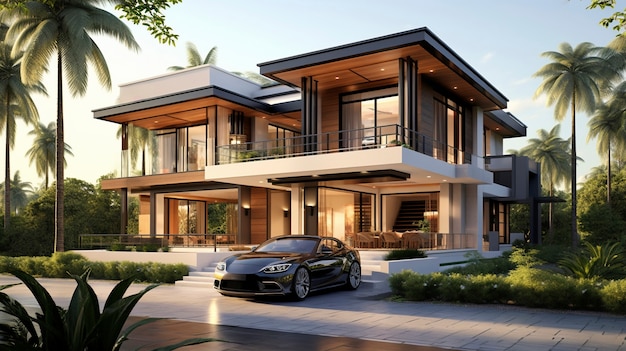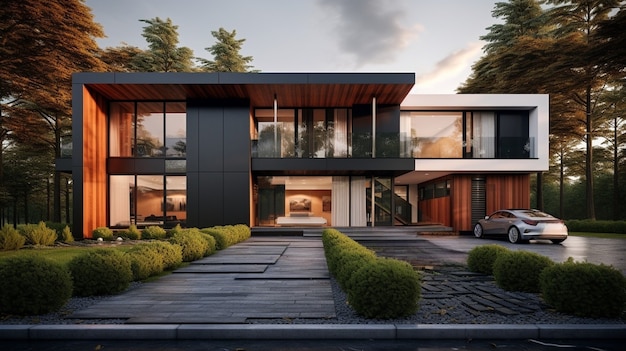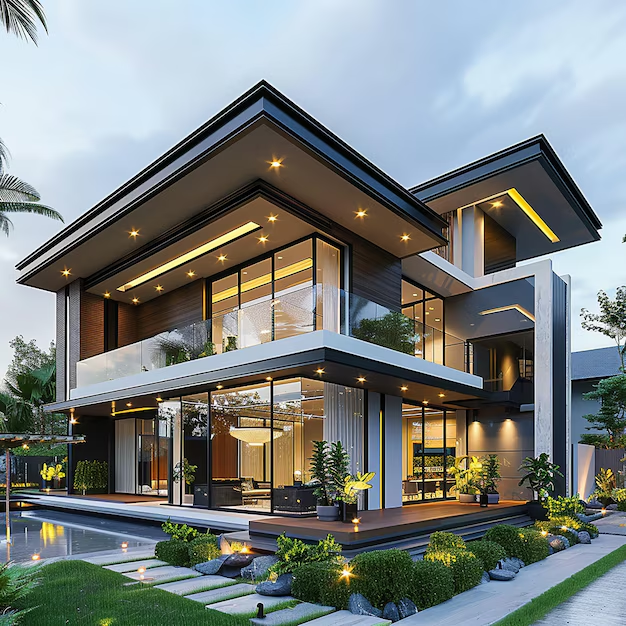Discover the essence of modern:tqosz3ibskc= house design, exploring innovative features, sustainability, and architectural trends shaping contemporary living.
Table of Contents
ToggleIntroduction
The modern house represents a radical departure from traditional architectural styles, emphasizing innovation, sustainability, and functionality. Characterized by clean lines, open spaces, and an abundant use of natural light, these homes cater to the needs and desires of contemporary living. Consequently, the design principles underpinning the modern house not only reflect the aesthetic preferences of today’s homeowners but also address environmental concerns and technological advancements, creating spaces that are both beautiful and practical.
Architectural Features of a Modern House
Architectural features of a modern house significantly distinguish it from other styles, making it instantly recognizable. Large windows often dominate the facade, inviting natural light into the living spaces while providing stunning views of the outdoors. This emphasis on transparency fosters a sense of connection to nature, essential in modern living. Furthermore, flat roofs and asymmetrical shapes contribute to a sleek, minimalist aesthetic that prioritizes functionality without sacrificing beauty, allowing architects to explore innovative designs that break from conventional norms and traditions.
The Importance of Open Floor Plans
One of the defining characteristics of a modern house is its open floor plan, which encourages fluid movement and interaction among different living spaces. By eliminating walls between the kitchen, dining, and living areas, homeowners can create a more cohesive environment that fosters social engagement. Moreover, this design choice not only maximizes the available space but also enhances the overall functionality of the home, making it ideal for families and entertaining guests. Consequently, open floor plans have become a popular choice for modern house designs, reflecting the evolving needs and lifestyles of contemporary homeowners.
Use of Natural Materials
The use of natural materials in the construction of modern houses further emphasizes the connection between indoor and outdoor spaces. Wood, stone, and metal are commonly utilized to create warm, inviting environments while maintaining a contemporary aesthetic. For instance, exposed wooden beams can add character and warmth to a modern living area, while natural stone can serve as a stunning focal point in outdoor landscaping. By incorporating these materials, designers can create homes that feel grounded in their surroundings, fostering a sense of harmony with nature and enhancing the overall living experience.

Incorporating Sustainable Design
Sustainability plays a vital role in modern:tqosz3ibskc= house design, reflecting a growing awareness of environmental issues and the importance of energy efficiency. Many modern houses incorporate features such as solar panels, energy-efficient appliances, and sustainable building materials to minimize their ecological footprint. Moreover, green roofs and rainwater harvesting systems can contribute to a home’s sustainability, reducing water usage and promoting biodiversity. By prioritizing sustainable design, modern houses not only provide homeowners with lower utility costs but also support a healthier planet, aligning with the values of environmentally conscious individuals.
Emphasizing Natural Light
Natural light is a crucial element in modern house design, as it enhances the overall ambiance and well-being of the inhabitants. Large windows, skylights, and open layouts work together to maximize the amount of sunlight entering the home, creating bright and airy spaces that promote a positive atmosphere. Furthermore, well-placed windows can provide cross-ventilation, improving indoor air quality and reducing reliance on artificial lighting and climate control systems. As a result, modern houses are often designed with an acute awareness of how light interacts with space, reflecting the importance of well-being in contemporary living.
Outdoor Living Spaces
Modern houses often blur the lines between indoor and outdoor living, emphasizing the importance of outdoor spaces for relaxation and entertainment. Patios, decks, and gardens serve as extensions of the home, offering additional areas for socializing and enjoying nature. By integrating these outdoor spaces into the overall design, homeowners can create a seamless flow between their indoor and outdoor environments, enhancing their quality of life. Additionally, thoughtful landscaping can enhance the aesthetic appeal of a modern house, creating a beautiful backdrop that complements the sleek lines and minimalist design of the home.
Technological Advancements in Modern Homes
Incorporating technology into the design and functionality of modern houses has transformed the way homeowners interact with their living spaces. Smart home technology enables residents to control various aspects of their home, such as lighting, heating, and security systems, from their smartphones or tablets. Moreover, energy-efficient appliances and systems contribute to lower utility costs and increased convenience, allowing homeowners to maintain a comfortable environment with minimal effort. As technology continues to evolve, modern houses will increasingly embrace innovations that enhance the living experience, making them more adaptable to the needs of their inhabitants.
The Role of Minimalism in Modern House Design
Minimalism is a key principle in modern:tqosz3ibskc= house design, promoting simplicity and functionality while eliminating unnecessary clutter. This aesthetic approach encourages homeowners to focus on quality over quantity, investing in meaningful pieces that enhance their living spaces. As a result, modern houses often feature clean lines, neutral color palettes, and carefully curated furnishings that create a serene atmosphere conducive to relaxation and well-being. By embracing minimalism, modern houses provide an environment that fosters mindfulness and intentionality, aligning with the values of contemporary living.

The Importance of Flexibility in Design
Flexibility is an essential aspect of modern house design, allowing homeowners to adapt their living spaces to accommodate changing needs over time. Multi-functional rooms can serve various purposes, from home offices to guest bedrooms, enabling residents to make the most of their available space. Furthermore, modular furniture and movable partitions can facilitate easy reconfiguration, ensuring that the home remains functional and relevant as family dynamics evolve. By prioritizing flexibility, modern houses can better meet the diverse and ever-changing requirements of today’s homeowners.
Integrating Art into Modern Spaces
Art plays a significant role in modern house design, as it can enhance the aesthetic appeal and create a personalized atmosphere. Whether through bold statement pieces or carefully curated collections, art can serve as a focal point that reflects the homeowner’s unique tastes and experiences. Additionally, the integration of art into modern spaces can contribute to a sense of identity and belonging, fostering a connection between the inhabitants and their environment. By thoughtfully incorporating art, modern houses can elevate their design while creating meaningful connections to the individual lives of their residents.
The Influence of Cultural Trends
Cultural trends heavily influence modern:tqosz3ibskc= house design, as architects and designers draw inspiration from diverse styles, materials, and techniques. This fusion of influences can result in innovative and eclectic designs that reflect the values and preferences of contemporary society. For instance, the growing interest in sustainable living has led to the rise of eco-friendly materials and energy-efficient technologies in modern houses, while global design trends have encouraged a blending of aesthetics from various cultures. Consequently, modern house designs are often dynamic and fluid, adapting to the ever-evolving landscape of contemporary culture.
Community and Modern House Design
The design of modern houses also considers the importance of community and social interaction. Many modern neighborhoods prioritize walkability, shared spaces, and a sense of connection among residents, encouraging a more cohesive living environment. By incorporating communal areas, such as parks and gathering spaces, modern houses can foster a sense of belonging and promote social engagement among neighbors. Furthermore, these design principles help to create vibrant communities that reflect the values of collaboration and inclusivity, enhancing the overall quality of life for residents.
The Evolution of Modern House Styles
Modern house styles have evolved over time, adapting to changing architectural trends and cultural influences. Early modernist designs emerged in the early 20th century, characterized by their emphasis on simplicity and functionality. As the movement progressed, various styles, such as mid-century modern and contemporary, emerged, each reflecting the unique preferences and values of their respective eras. Today, modern houses continue to evolve, incorporating new materials, technologies, and design philosophies that cater to the diverse needs of contemporary homeowners, ensuring that the concept of the modern house remains relevant and appealing.
The Benefits of Living in a Modern House
Living in a modern house offers numerous advantages, from enhanced energy efficiency to improved quality of life. The thoughtful design principles that underpin modern homes prioritize functionality, comfort, and sustainability, creating environments that support the well-being of their inhabitants. Moreover, the emphasis on natural light and open spaces contributes to a positive atmosphere, fostering creativity and relaxation. As a result, modern houses not only provide practical benefits but also enrich the lives of those who call them home, making them a desirable choice for many individuals and families.

Challenges in Modern House Design
Despite their many benefits, modern:tqosz3ibskc= house designs can also present challenges, particularly regarding affordability and accessibility. The incorporation of high-quality materials, cutting-edge technology, and innovative design elements can lead to increased construction costs, making modern homes less attainable for some buyers. Additionally, navigating local building codes and zoning regulations can complicate the design and construction process, posing obstacles for architects and homeowners alike. By addressing these challenges, the industry can work towards creating modern houses that are accessible to a wider range of individuals, ensuring that the benefits of contemporary living are available to all.
The Future of Modern House Design
The future of modern house design holds exciting possibilities, as architects and designers continue to push the boundaries of creativity and innovation. As technology advances, the integration of smart home systems, sustainable materials, and energy-efficient technologies will likely become even more prevalent in modern houses. Additionally, the growing awareness of environmental issues and social responsibility will influence design decisions, prompting a focus on eco-friendly practices and community-oriented solutions. Ultimately, the evolution of modern house design will reflect the values and aspirations of future generations, ensuring that these homes remain relevant and impactful for years to come.
Conclusion
The modern:tqosz3ibskc= house embodies a unique blend of innovation, style, and sustainability, catering to the diverse needs and desires of contemporary living. With their open floor plans, abundant natural light, and emphasis on connection to the outdoors, modern houses create harmonious environments that foster well-being and enhance quality of life. As architectural trends continue to evolve, modern houses will remain at the forefront of design, reflecting the changing values and preferences of society while embracing the opportunities presented by technology and sustainability.
Read Also: Exploring the Innovations and Insights of www. disquantifiedorg





